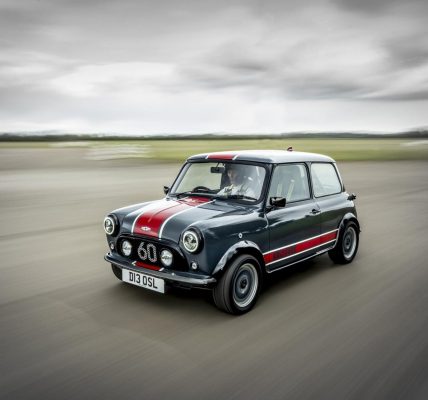2021 Toyota Highlander review
We see if Toyota’s entry to the seven-seat SUV market has what it takes to defeat its rivals
Standing up close for the first time, next to the new — well, new to the UK — seven-seater Toyota Highlander, for a split second I could imagine what it must have been like for the youngsters in the 1989 movie, . The Highlander has the effect of making everything around it feel small. It’s massive.You’ll not be surprised to learn that at 4,966mm long, 1,930mm wide and 1,755mm tall — that’s about two inches in old money, taller than me — the Highlander is significantly larger than the RAV4 stablemate it shares its platform with, that being the GA-K version of Toyota’s TNGA Architecture.And while the behemoth that is the Highlander has been around for 21 years, racking up sales in the likes of the USA, Russia and Japan, its debut on UK streets will turn heads … possibly due to passersby wondering where the sun has disappeared to as the Toyota cruises by quietly.It’s actually the fourth-generation of the big seven-seater, but only now has Toyota in the UK decided the time is right to bring it to these shores. Good timing, as sales of rivals, such as the Skoda Kodiaq, Land Rover Discovery, Volvo XC90 and Kia Sorento are all on the up.Just a pity that it’s arrival also coincided with the RAC Foundation preaching that drivers in crowded cities should think twice before buying a big SUV. But let’s not get into that discussion at the moment.
Whatever the RAC Foundation thinks, Toyota likes SUVs. The current range also includes the C-HR, the aforementioned RAV4, plus the offroading, go-anywhere maestro that is the Land Cruiser. And not only has it recently unveiled the Yaris Cross, but its Aygo city car has been reinvented as a crossover. Excellent.Clearly the Highlander is built for urban use. You’re not going to be taking it axle-deep through the nearest quarry or cloying mud. This is the road-focused large family SUV for the growing family; the parents with two or three kids who regularly go on trips with their friends (well, will do post-Covid travel restrictions).
Toyota Highlander price and spec
UK buyers have the choice of two trim levels. The Highlander Excel will account for the lion’s share — around 80 per cent — of sales, and is priced from £50,595. The Excel Premium will set you back £52,575.As you would expect, even on the “cheaper” model, standard kit is comprehensive, including a panoramic roof, a power-operated boot opening, a heated steering wheel, front and rear parking sensors plus a reversing camera, puddle lights, three-zone climate control, and black leather upholstery on all seven of the Highlander’s seats. Oh, and the driver and front passenger get heated seats.Inside the massive cabin — you might need to install your own walkie-talkie system to establish comms between the front seat passenger and the kids in the third row — there’s an eight-inch touchscreen infotainment unit with navigation, Apple CarPlay and Android Auto.This is supplemented by a seven-inch driver information display, plus there’s a wireless smartphone charger hidden in the central storage compartment, and an impressive 11-speaker sound system from JBL. There’s also an array of USB and other charging ports.The 20 per cent of buyers who opt for the Excel Premium benefit further from heated rear seats and ventilated fronts, a top-down parking camera, and a head-up display, amongst other additions.
Drivetrain
As you’d expect this being a Toyota, the Highlander is a hybrid. Both models get the latest evolution of Toyota’s 2.5-litre petrol-electric setup; it’s mightily impressive across the board of driving situations you’ll find yourself in.Important to stress, this isn’t a plug-in hybrid system, as slotted into the RAV4 PHEV. The Highlander uses Toyota’s most powerful “self-charging” hybrid with 244bhp. It has a claimed 0-62mph of 8.3 seconds and, thanks to the extra power, it isn’t too hard to get a shift on.Mating the 2.5-litre petrol engine, small battery and electric motor system combines to create a power-split hybrid system. The result is the Highlander can run on electric power only over short distances, but also the electric motors drive the wheels when the engine is brought into play with the petrol powerplant acting as a generator for the battery.This all of course means, rather thankfully, that being a self-charger and not a plug-in there are no 180+mpg fuel figures quoted. On no. The Highlander operates in the real world, which is why Toyota claims up to 39.9mpg on the combined cycle. With a gentle right foot, on my 90-mile test route through South Sussex I eked it just over 40mpg.The CVT gearbox is standard and jumping from a traditional seven-speed auto ‘box in my car to the Toyota it still takes a little while to get used to the CVT’s idiosyncratic charms. Once you’re up to speed in town you can slip the Highlander into the EV mode via a button near the chunky gear selector. The result? You glide silently around city streets at speeds up to 38mph; then the petrol engine eases into play to assist the small battery.
Interior space
Put simply, the Highlander is vast. Plus it’s heavily configurable. Push the second row of seats back its full 180mm, and there’s a huge amount of legroom for passengers sitting there. Honestly, it’s huge.Seven seats are standard and, slide the second row of seats to its central position — which doesn’t compromise space there too badly — and, certainly for shorter trips, two adults could be accommodated in the third row. For very easy access to the rear, the central row simply pushes all the way up to the back of the front seats. For greater comfort, all seven seats can recline fore and aft. And let’s be honest, the vast bulk of use for the third row will be for kids … and they’ll love it.Bootspace is like the landing deck of an aircraft carrier. In five-seat mode, with the rear deck tucked beneath the floor, you can store 658 litres up to the tonneau cover. With the second row folded flat, the capacity is 1,177 litres, rising to 1,909 litres if you pack up to the roof. Fill all seven seats with driver and passengers, and there’s still 332 litres in the boot; that’s similar volume to a popular supermini.
Verdict
In what is a rather niche, but growing market, the Highlander makes a strong statement in the battle of the seven-seaters. Ignore the fact its styling leaves it with a Stateside anonymous look; instead strip it down to considering exactly why you would need it, and the big Toyota is perfectly fit for purpose.
Humungous as it unquestionably is, the one lasting impression I have of the Highlander is that it never actually felt big driving it. And that was despite having to negotiate some very narrow village lanes and single-track roads.Of course there are more established rivals out there, boldly flaunting their badges, but if you’re a family in need of a seven-seater, don’t make a decision without at least trying the Highlander.
£50,595-£52,575; 2.5-litre, four-cylinder petrol plus two electric motors; 244bhp (combined) 176lb/ft (engine), 89lb/ft (motor); e-CVT, all-wheel drive; 111mph; 8.3 seconds; 39.2-39.9mpg; 160-163g/km










